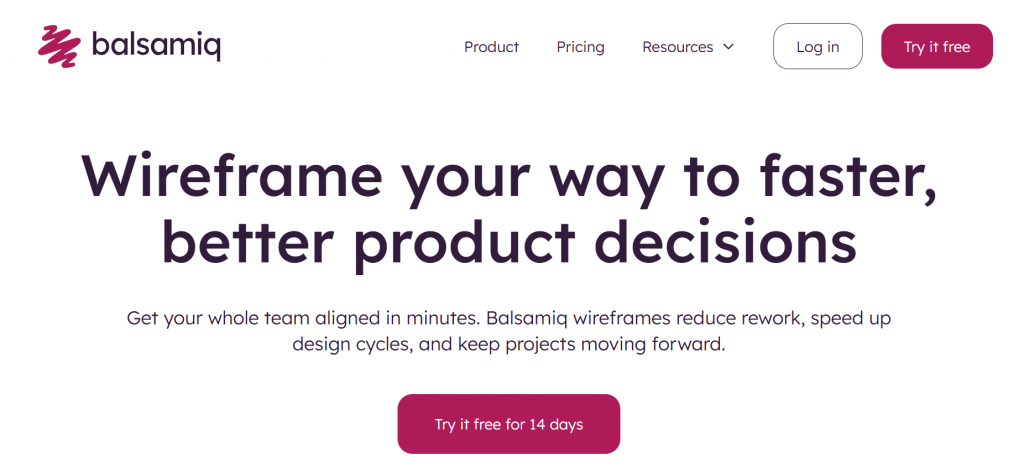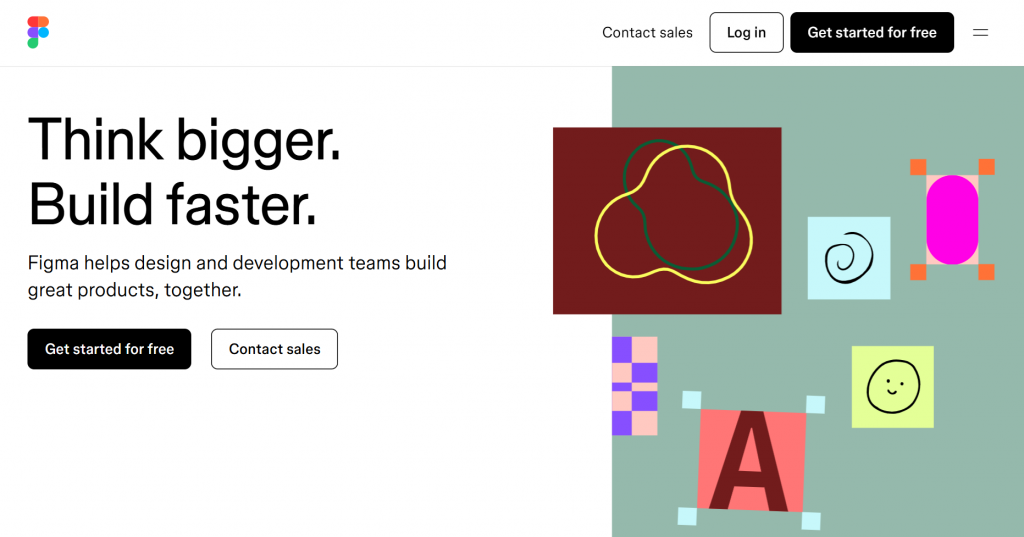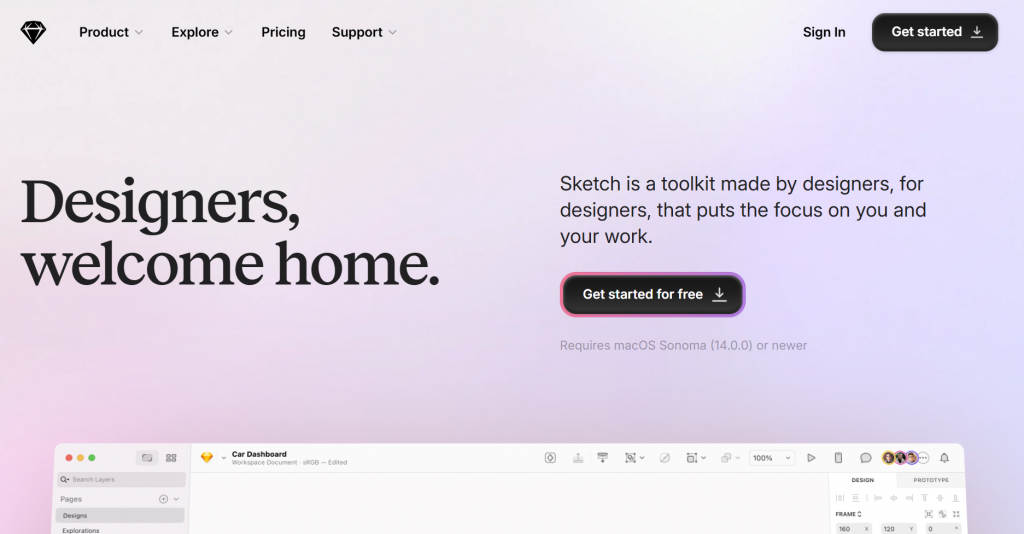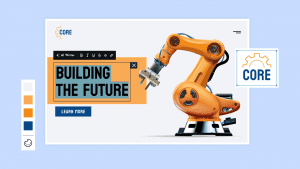Key takeaways:
- Wireframes are digital blueprints that prioritize a website’s structure and user experience over visual design.
- Using wireframes early in the design process helps align stakeholders and catch issues before development.
- The three main types of wireframes (low, mid, and high-fidelity) allow you to progress from a simple sketch to a detailed plan.
Creating a new website or app is like building a house. You wouldn’t start hammering away without a plan, right? That’s where a wireframe comes in. It’s like your digital blueprint, an outline for your project that will save you from many headaches and expenses down the road.
So, what exactly goes into these digital blueprints, and why should you care about them for your small business? We’ll take a closer look at what wireframes include, why they’re key to a smooth user experience (UX), and how they fit into the bigger picture of web design.
What are wireframes?
A wireframe is a website or app’s skeletal framework. It’s a low-fidelity, black-and-white layout that focuses on a web page’s structure, user flow, and functionality. The key purpose of a wireframe is to establish the basic layout of a website or app before applying any visual design, colors, or branding.
A typical wireframe includes core layout elements such as headers, navigation menus, content blocks, and forms. It allows you to visualize connections between page parts and ensures optimal UX from the beginning, satisfying user and business needs.
By stripping away all the design frills, wireframes help you focus on what truly matters: where everything goes and how everything works. Wireframes also help you get early user feedback on your structure before adding more details that could impact the final design.
Why are wireframes important in digital projects?
Wireframes are key to your project’s success and overall web development process.
Here’s why wireframes are important for any digital project:
- They’re a communication tool
- They improve UX design
- They save time and money
- They allow for early feedback
They’re a communication tool
Wireframes help align everyone involved in the project, from your team to your stakeholders. Your team can deliberate on the basic framework before moving on to more complex elements when they focus on structure and layout.
Wireframes are also great for communicating complex concepts in a simpler way.
They improve UX design
Wireframes force you to consider the user’s journey. You can map out the navigation flow and ensure the layout is intuitive and easy to use. Focusing on UX from the beginning, you help ensure your final product is logical and functional for your audience.
They save time and money
Catching potential problems early is a huge advantage. You can avoid costly and time-consuming redesigns by identifying issues with the layout or navigation in the wireframe stage. This concept, “avoiding design debt,” can make the difference between being on budget and running over.
They allow for early feedback
Wireframes are a great way to get early user feedback from stakeholders and users. Since they don’t have colors or flashy graphics, the focus stays on the functionality and user flow. These simple layouts help you gather honest, unbiased feedback about the structure of your website or app.
What are the different types of wireframes?
Just as a house blueprint can be a simple sketch or a detailed architectural drawing, wireframes also come in different levels of detail (fidelity). The three main types are low, mid, and high-fidelity wireframes.
- Low-fidelity wireframes
- Mid-fidelity wireframes
- High-fidelity wireframes
Low-fidelity wireframes
Low-fidelity wireframes are the most basic type, often created using simple tools like pencil and paper. They’re quick, rough sketches focusing on the big picture—overall layout, main elements, and user flow.
They’re not concerned with specifics like exact text or image sizes. Speed is key here; they allow you to quickly brainstorm ideas and test concepts at the start of a project.
Mid-fidelity wireframes
Mid-fidelity wireframes sit above low-fidelity, often created with digital tools and with more details. While they still lack branding, colors, and images, they use different font weights and sizes to indicate headings and text hierarchy.
These wireframes are great for communicating a more refined format to stakeholders and solidifying designs before moving to the following stages. They help ensure all key elements of UX are accounted for.
High-fidelity wireframes
High-fidelity wireframes are the most detailed and polished type, almost identical to the final product in layout and content. They include specific images, actual text content, and even interactive elements to simulate actual UX.
Before reaching the final stages, they usually present the final structure and functionality to clients and stakeholders. They help confirm that everyone on the project team is on the same page before you get into the nitty-gritty of coding and design.
What is a wireframe’s basic structure?
What exactly is on that blueprint? It should include the core layout elements that make a web page functional.
Here’s a breakdown of what a wireframe typically includes:
- Layout elements. These are the building blocks of your page. Layout elements include the header, which is usually at the top, the navigation bar, content blocks for text and images, and the footer at the bottom.
- Navigation. A key part of any wireframe is mapping how users will move through your site. This involves showing the main menu and other links connecting different pages.
- Interactive elements. Wireframes should outline where important interactive features will be, such as buttons, forms for collecting information, and calls-to-action (CTAs).
- Placeholders. Wireframes often use simple boxes and gray blocks as placeholders for images, videos, and large chunks of text. This ensures that you focus on the page’s flow and structure without being distracted by the visual content.
Regardless of what you’ll include in your wireframe, it should avoid colors, branding, and final graphics.
Do all websites need wireframes?
Like many things in business, it depends. While a wireframe is almost always helpful, whether it’s necessary depends on the size of your project.
For large, complex projects like a full-scale eCommerce website or a custom web application, wireframes are necessary. They help you plan a complex user flow and ensure all parts work together well. When multiple stakeholders are involved, wireframes are important to keep everyone on the same page and catch potential issues early.
But if you’re building a simple, single-page website or tweaking an existing one, you can get by without a formal wireframe. For example, if you have a clear vision for a basic landing page, you can skip the wireframe step and go straight to design.
Think of wireframes as checklists or detailed plans. For a simple task, like painting a room, a mental checklist might be enough. But for a larger project, like renovating an entire floor, a detailed plan is important to ensure everything is right. While you might be able to skip wireframing for simple projects, it’s a best practice that almost always saves time and resources in the long run.
How do we create wireframes?
Now that you know what a wireframe is and its importance, you may wonder how they’re created. The wireframing process is straightforward and doesn’t require any advanced design skills, as shown in this simple, step-by-step guide:
- Define your goals. Before you draw, you need to know what you’re trying to accomplish. What is your web page or app’s purpose? What actions do you want users to take? Having a clear goal in mind will guide your decisions throughout the process.
- Sketch the layout. Start with a rough sketch, either on paper or a whiteboard. Block out the basic structure and placement of major interface elements like headers, navigation, and content areas. Don’t worry about perfection; the goal is to get your ideas down quickly.
- Add content blocks. Once the basic layout is in place, start adding placeholders for your content. Use simple boxes to represent where images will go and lines to represent text. This helps you visualize the hierarchy of information on the page.
- Map out navigation. Next, think about how users will move from one page to another. Draw arrows and labels to show the navigation flow and how different pages will connect.
- Get feedback. Share your wireframe with your team or stakeholders and gather their feedback. Since the wireframe is just a basic layout, it’s easy to make changes based on their input at this stage.
What’s the difference between wireframes, mockups, and prototypes?
You may have also heard of other terms “mockups” and “prototypes.” While they all play a role in the design process, they each serve a different purpose.
Here is a table outlining the key differences between wireframes, mockups, and prototypes.
| Feature | Wireframe | Mockup | Prototype |
| Purpose | To define structure and layout | To finalize visual design | To test user interaction |
| Fidelity | Low | High | High |
| Visual Design | ❌ | ✅ | ✅ |
| Interactivity | ❌ | ❌ | ✅ |
| Branding/Colors | ❌ | ✅ | ✅ |
| User flow | ✅ | ✅ | ✅ |
| Content | Placeholder | Real | Real |
To elaborate on what the table presents:
- Wireframes are the blueprint. They are simple, black-and-white layouts that focus on structure, user flow, and functionality. They answer the question, “Where does everything go?”
- Mockups are the visual design. They add the visual elements to the wireframe: colors, images, fonts, and branding. They show the website’s appearance for a static, detailed visual of the final product.
- Prototypes are the working models. A prototype is a clickable, interactive version of the mockup. It simulates how users navigate and interact with the website or app, allowing you to test UX before any code is written. This is the stage where thorough user testing takes place.
In a typical project, the layout is wireframed, followed by a mockup to finalize the visual design, and finally, a prototype to test the UX before development begins.
What are the best wireframing tools?
You can always start with a pen and paper, but you can use digital tools for streamlining and collaboration. Here are three popular options for creating wireframes:
- Balsamiq
- Figma
- Sketch
Balsamiq

Source: balsamiq.com
Think of Balsamiq as a digital whiteboard. It’s known for its simple, sketch-like interface, which makes it feel like you’re drawing with a pen but digitally. It’s perfect for beginners and quickly brainstorming ideas without getting bogged down in complex features.
Figma

Source: figma.com
A popular choice for wireframing and full-scale design, Figma is a collaborative tool allowing multiple people to work on the same file in real time. This makes it an excellent option for teams. It’s a robust tool that can handle everything from low-fidelity wireframes to high-fidelity prototypes.
Sketch

Source: sketch.com
While primarily known as a powerful user interface (UI) design tool, Sketch is also a great option for creating detailed wireframes. It’s a popular choice for designers who want a single tool that can take them from the early wireframing stage to a finished design.
Do you need a wireframe?
You don’t always need a wireframe, but knowing when to use one can save you a lot of time and effort. While the answer isn’t a simple “yes” or “no,” the complexity of your project is often the deciding factor. Here’s a quick guide to help you decide if a wireframe is the right step for your specific needs.
You most likely need a wireframe if:
- You’re building a new website or app from scratch. Creating an initial wireframe is the most efficient way to plan the project’s structure.
- Your project is complex. By complex, we’re talking about anything with multiple pages, a custom user flow, e-commerce functionality, or user-specific accounts. A wireframe helps you map out all these interactions before codes are written.
- You need to get a team or stakeholders on the same page. A wireframe helps everyone involved understand and agree on the project’s structure before moving on to visual design.
You can skip a formal wireframe if:
- You’re making simple updates or minor changes, like adding a new section to an existing page.
- Your project is small and simple. By simple, we mean something as simple as a single-page landing page or a basic online portfolio.
- You’re working on a personal project with a clear vision. If you are the only person involved and fully grasp the layout, you may jump straight to the design phase.
Bring wireframes to life with Network Solutions
Now that your wireframes are complete, it’s time to bring that blueprint to life. Network Solutions provides all the tools you need to build on the solid foundation you’ve created.
Our Website Builder is designed to turn your wireframes into fully functional websites that meet user and business needs. Whether you’re ready to start building on your own with our tools or want to collaborate with our expert design team, we can help you turn your vision into a reality.
Frequently asked questions
Wireframes serve as layouts for the basic structure, layout, and functionality of a website or app before designing or coding. It’s a visual guide that helps everyone on the project team agree on the core framework.
The completion time of a wireframe varies, but it can range from a few hours for a low-fidelity sketch to several days for a high-fidelity design.
Wireframing is not about artistic skill; it’s about communicating layout and structure. Simple basic shapes, boxes, and text placeholders can effectively do this.
Most wireframes are not clickable, as they show a page’s static layout and structure. However, some high-fidelity wireframes can be interactive to simulate a user’s journey.
Sharing wireframes with clients helps elicit user feedback and ensure everyone is on the same page before moving on to design and development.




